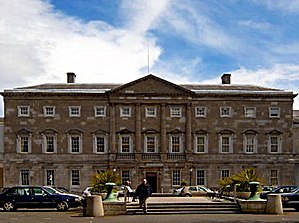Althing (Azmara)
This article is incomplete because it is pending further input from participants, or it is a work-in-progress by one author. Please comment on this article's talk page to share your input, comments and questions. Note: To contribute to this article, you may need to seek help from the author(s) of this page. |
Parliament of Azmara Alþing | |
|---|---|
| Type | |
| Type | |
| Houses | • Landsmot • Folksmot |
| Leadership | |
President of the Landsmot | Alana Jonsdohter, Independent since 14 May 2020 |
President of the Folksmot | Leif Freissun, Workers' Party since 22 April 2020 |
| Structure | |
 | |
Landsmot political groups | Government (42)
Opposition (33)
|
 | |
Folksmot political groups | Government (84)
Opposition (66)
|
| Elections | |
Landsmot voting system | Indirect election |
Folksmot voting system | Closed-list proportional representation |
Landsmot last election | 10 May 2020 |
Folksmot last election | 19 April 2020 |
| Meeting place | |
 | |
| Stefansburg House, Aalmsted, Azmara | |
| Website | |
| www | |
The Alþing, often estmerified as Althing, also known as the Parliament of Azmara, is the bicameral legislature of the Commonwealth of Azmara. It is comprised of both the Landsmot and the Folksmot, both of which meet at Stefansburg House in Aalmsted. The Folksmot is the more important of these two chambers - the Landsmot only has the power to delay and amend, not reject legislative proposals, and can not deny confidence to the Government of Azmara.
While a bicameral body known as the Alþing serving as the national legislature of Azmara has existed since the creation of an Azmaran state in 1623, the creation of the modern legislature is often put to 1855, when the current principle of imperfect bicameralism was introduced and property qualifications for the Folksmot were abolished as part of the Radical Revolution - the pre-1855 legislature is thus often referred to as the Alþing of the Estates to distinguish it from the modern body. The powers of the legislature were expanded further by the 1915 constitution as it shifted the country from a presidential system to a parliamentary one.
The Folksmot's 150 members are elected through party-list proportional representation using the eight provinces as constituencies for three-year terms, while the Landsmot's 75 members are chosen through a mixed system - 40 are chosen by the provincial governments while 35 are elected by five "functional constituencies" representing trade unions, employers' organisations, small businesses and agriculture, university graduates and cultural organisations respectively.